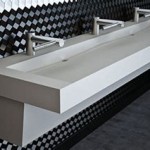How To Get Rid Of Hard Water Stains In Bathroom Sink
Hard water, characterized by a high mineral content, primarily calcium and magnesium, presents a persistent challenge in maintaining the cleanliness and aesthetics of bathroom fixtures. The residue left behind after water evaporates, commonly known as hard water stains, can accumulate on surfaces, particularly in bathroom sinks. These stains are not only unsightly but can also become increasingly difficult to remove over time if left untreated. Understanding the nature of hard water stains and employing effective cleaning methods are crucial for preventing their buildup and restoring the pristine condition of bathroom sinks.
The formation of hard water stains is a direct consequence of the mineral composition of the water supply. When hard water comes into contact with surfaces, the dissolved minerals precipitate and form a visible film. In bathrooms, this process is accelerated due to frequent water usage and evaporation. The resulting stains can appear as white, chalky deposits or, in some cases, develop a rusty or brownish hue due to the presence of iron or other minerals. The severity of the staining depends on the water hardness level, the frequency of water exposure, and the type of surface material. Porcelain, ceramic, and stainless steel sinks are all susceptible to hard water stains, although the visibility and ease of removal may vary.
Regular cleaning is the first line of defense against hard water stains. Wiping down the sink after each use can significantly reduce the accumulation of mineral deposits. However, for existing stains, more aggressive cleaning methods are necessary. A variety of commercially available cleaning products are designed to remove hard water stains. These products typically contain acids or chelating agents that dissolve the mineral deposits. Alternatively, several household remedies offer effective and economical solutions for tackling hard water stains in bathroom sinks. The following sections will explore various cleaning methods, both commercial and homemade, along with preventative measures to minimize the occurrence of hard water stains.
Understanding the Characteristics of Hard Water Stains
To effectively combat hard water stains, it is essential to understand their composition and behavior. Hard water stains are primarily composed of calcium carbonate (CaCO3) and magnesium hydroxide (Mg(OH)2), which are insoluble mineral compounds. These compounds adhere strongly to surfaces, forming a tenacious layer that resists removal by simple washing with soap and water. The alkalinity of these mineral deposits contributes to their resistance to acidic cleaning agents.
The accumulation of hard water stains is not a static process. Over time, the mineral deposits can react with other substances in the environment, such as soap scum, grime, and even atmospheric pollutants. These interactions can create a more complex and hardened layer of stain, making it even more challenging to remove. Furthermore, the porous nature of some sink materials, such as certain types of ceramic, can allow the mineral deposits to penetrate deeper into the surface, exacerbating the problem.
The appearance of hard water stains can vary depending on the specific minerals present in the water supply. Calcium and magnesium typically result in white or chalky deposits, while iron can cause reddish-brown or rust-colored stains. Manganese, another common mineral in hard water, can produce brown or black stains. Identifying the color and texture of the stains can provide clues about their composition and inform the selection of appropriate cleaning methods.
The persistence of hard water stains is also influenced by the pH level of the water. Water with a high pH (i.e., alkaline water) tends to exacerbate the formation of hard water stains, as the alkalinity promotes the precipitation of minerals. Conversely, slightly acidic water can help to dissolve existing stains. Understanding the water chemistry is therefore crucial for implementing effective preventative measures and selecting appropriate cleaning strategies.
Effective Cleaning Methods for Hard Water Stains
Several methods can be employed to remove hard water stains from bathroom sinks, ranging from commercially available cleaners to common household ingredients. The choice of method depends on the severity of the staining, the type of sink material, and personal preferences regarding cleaning products.
Commercial Hard Water Stain Removers: Numerous commercial products are specifically formulated to remove hard water stains. These products typically contain acids, such as hydrochloric acid or phosphoric acid, or chelating agents, such as EDTA (ethylenediaminetetraacetic acid). Acids dissolve the mineral deposits by reacting with the calcium and magnesium compounds, while chelating agents bind to the mineral ions, effectively lifting them from the surface. When using commercial hard water stain removers, it is crucial to follow the manufacturer's instructions carefully. Always wear gloves and eye protection to prevent skin and eye irritation. Ensure adequate ventilation to avoid inhaling fumes. Test the product on an inconspicuous area of the sink before applying it to the entire surface to ensure it does not damage the material.
Vinegar: White vinegar is a readily available and effective household remedy for removing hard water stains. Vinegar contains acetic acid, which dissolves the mineral deposits. To use vinegar, saturate a clean cloth or sponge with undiluted white vinegar and apply it to the stained area. Allow the vinegar to sit for 15-30 minutes to allow the acid to react with the minerals. For stubborn stains, soak a paper towel in vinegar and place it directly on the stain, covering it with plastic wrap to prevent evaporation. Let it sit for several hours or overnight. After soaking, scrub the area with a non-abrasive sponge or brush to remove the loosened mineral deposits. Rinse thoroughly with water and dry the sink with a clean cloth. Repeat the process if necessary. Vinegar is generally safe for most sink materials, but it is advisable to test it on an inconspicuous area first, especially on porous or delicate surfaces.
Baking Soda Paste: Baking soda, also known as sodium bicarbonate, is a mild abrasive and a natural deodorizer. It can be used to remove hard water stains by creating a paste. Mix baking soda with water to form a thick paste. Apply the paste to the stained area and gently scrub with a non-abrasive sponge or brush. The mild abrasive action of the baking soda helps to loosen the mineral deposits. Rinse thoroughly with water and dry the sink with a clean cloth. For more stubborn stains, combine baking soda with vinegar to create a fizzing action that can help to break down the mineral deposits. Apply the mixture to the stained area and allow it to fizz for a few minutes before scrubbing and rinsing.
Lemon Juice: Lemon juice, like vinegar, contains citric acid, which can dissolve hard water stains. Cut a lemon in half and rub the cut side directly onto the stained area. Alternatively, squeeze lemon juice onto a clean cloth or sponge and apply it to the stain. Allow the lemon juice to sit for 15-30 minutes before scrubbing and rinsing. The natural acidity of the lemon juice helps to break down the mineral deposits, leaving the sink clean and smelling fresh. Lemon juice is generally safe for most sink materials, but it is advisable to test it on an inconspicuous area first.
Borax: Borax, also known as sodium borate, is a natural mineral with cleaning and disinfecting properties. It can be used to remove hard water stains by creating a paste. Mix borax with water to form a thick paste. Apply the paste to the stained area and gently scrub with a non-abrasive sponge or brush. Rinse thoroughly with water and dry the sink with a clean cloth. Borax is a stronger cleaning agent than baking soda, so it is important to wear gloves and avoid contact with eyes and skin. Test it on an inconspicuous area first before applying it to the entire sink.
Preventative Measures to Minimize Hard Water Stain Buildup
Preventing the buildup of hard water stains is often easier and more effective than removing them after they have accumulated. Several preventative measures can be implemented to minimize the occurrence of hard water stains in bathroom sinks.
Wiping Down the Sink After Each Use: The simplest and most effective preventative measure is to wipe down the sink with a dry cloth or towel after each use. This removes any residual water and prevents mineral deposits from forming as the water evaporates. This habit, while seemingly minor, dramatically reduces the frequency and intensity of necessary deep cleans.
Using a Water Softener: Installing a water softener is a more comprehensive solution for addressing hard water issues. Water softeners remove calcium and magnesium ions from the water supply, preventing the formation of hard water stains throughout the entire house, not just in the bathroom sink. Water softeners work by exchanging the hard water minerals for sodium or potassium ions. This process reduces the mineral content of the water, making it less likely to form stains. The initial investment for a water softener can be significant, but the long-term benefits include reduced cleaning efforts, extended lifespan of appliances, and improved water quality for bathing and washing.
Applying a Protective Coating: Applying a protective coating to the sink surface can help to repel water and prevent mineral deposits from adhering. Various commercially available coatings are designed for use on bathroom fixtures. These coatings create a hydrophobic layer that causes water to bead up and roll off the surface, minimizing the formation of stains. Regular application of a protective coating can significantly reduce the frequency and intensity of cleaning required.
Using a Squeegee: A squeegee can be used to remove excess water from the sink after each use. Using a squeegee, similar to how one would clean a shower door, quickly removes standing water, preventing the minerals from drying on the surface and forming stains. This is especially useful in areas with particularly hard water.
Regular Cleaning with Mild Detergent: Even with preventative measures in place, regular cleaning is still necessary. Washing the sink with a mild detergent and water at least once a week can help to remove any accumulated mineral deposits before they become hardened and difficult to remove. Avoid using abrasive cleaners, as they can scratch the sink surface and make it more susceptible to staining. A gentle cleaning routine maintains the sink's appearance and prevents severe stain build-up.

No More Hard Water Stains How To Easily Clean Your Porcelain Sink In Minutes Vooki

5 Methods For Removing Hard Water Stains Bob Hoegler Plumbing

Easy Way To Remove Hard Water Stains Domestically Speaking

How To Remove Hard Water Stains In Your Bathroom

How To Get Rid Of Iron And Rust Stains Once For All Water Right

Removing Hard Water Stains From Bathroom Sinks

Removing Hard Water Stains From Bathroom Sinks

How To Remove Rust Stains From Toilets Tubs And Sinks

Diy Limescale Hard Water Stain Solutions Aquarius Home Services

How To Get Rid Of Hard Water Stains In Bathrooms Harpic
Related Posts







